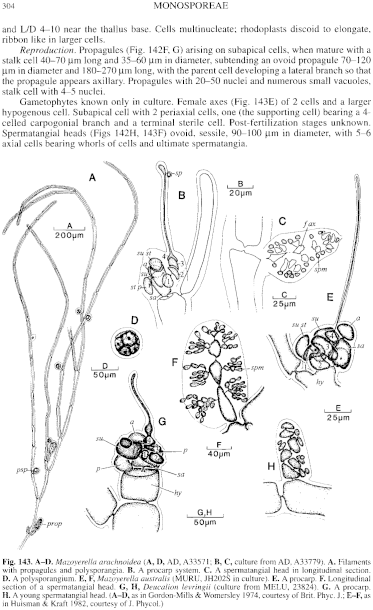|
|
|
|
|
|||||||||||
|
Electronic Flora of South Australia Species Fact Sheet
Phylum Rhodophyta – Order Ceramiales – Family Ceramiaceae – Tribe Monosporeae
Selected citations: Huisman & Kraft 1982: 189, figs 27–29.
Synonyms
Corynospora arachnoidea Harvey 1859b: 333.
Monospora arachnoidea (Harvey) J. Agardh 1876: 610. De Toni 1903: 1300 Lucas 1909: 48; 1929a: 24. Sonder 1881: 28.
Thallus (Fig. 142A) dark red-brown, erect, 0.5–4 (–5) cm high, forming slender, much branched tufts, subdichotomously branched every 1–3 (–6) cells (Fig. 142B); prostrate filaments absent. Attachment by elongate multicellular rhizoids from lower axial cells. Epiphytic on Dasya villosa or probably epilithic. Structure. Apical and upper cells 4–16 µm in diameter and L/D 4–20, median cells (20–) 25–50 µm in diameter and L/D 4–10, lower cells 100–250 µm in diameter and L/D 4–10. [Lower cells in one collection (AD, A41085) 250–450 µm in diameter with corticating rhizoids within the cell wall.] Cells multinucleate; rhodoplasts discoid to elongate, reticulate in larger cells.
Reproduction: Propagules (Figs 142B, 143A) on unicellular stalks on cells of erect filaments, single celled, elongate-ovoid, (40–) 60–90 µm in diameter, multinucleate.
Gametophytes dioecious. Procarps (Fig. 143B) on the subapical cell of short 2-celled axes on a larger subhypogenous cell which develops a lateral branch, with 2 periaxial cells, one (the supporting cell) bearing a 4-celled carpogonial branch and a terminal sterile cell. Post-fertilization the auxiliary cell produces usually 3 gonimolobes 40–160 µm across of ovoid carposporangia 15–30 µm in diameter, and the sterile procarp cells (apical, sterile periaxial and supporting sterile cell) produce slender involucral filaments around the young carposporophyte (Fig. 142C). Spermatangial heads (Fig. 142D) sessile on upper cells, slightly elongate, 25–35 (–55) µm in diameter, with usually 4 axial cells (Fig. 143C) producing initials radially and outer spermatangia.
Polysporangia (Fig. 143A, D) occur on upper cells, sessile, subspherical, 35–65 µm in diameter, with 8 or 16 spores.
Type from Georgetown, Tas. (Harvey); lectotype in Herb. Harvey, TCD.
Selected specimens: Troubridge Light, S. Aust., on Dasya villosa, 18 m deep (Shepherd, 4.ii.1969; AD, A33571). Investigator Strait, S. Aust., 33 m deep (Watson, 24.i.1971; AD, A41085). Port Noarlunga, S. Aust., on D. villosa, drift (Womersley, 20.iii.1969; AD, A33779). American R. inlet, Kangaroo I., S. Aust., drift at jetty (Womersley, 25.viii.1963; AD, A26780).
Distribution: Troubridge Light to American R. inlet, Kangaroo I., S. Aust., and N Tasmania.
Taxonomic notes: Collection AD, A37361, from Elliston, S. Aust., was incorrectly placed by Gordon-Mills & Womersley (1974, p. 127) under M. arachnoidea, but separated by Huisman & Gordon-Mills (1994, p. 82) as the type of Tanakaella itonoi.
References:
AGARDH, J.G. (1876). Species Genera et Ordines Algarum. Vol. 3, Part 1- Epicrisis systematic Floridearum, pp. i-vii, 1–724. (Weigel: Leipzig.)
DE TONI, G.B. (1903). Sylloge Algarum omnium hucusque Cognitarum. Vol. 4. Florideae. Sect. 3, pp. 775–1521 + 1523–1525. (Padua.)
GORDON-MILLS, E.M. & WOMERSLEY, H.B.S. (1974). The morphology and life history of Mazoyerella gen. nov. (M. arachnoidea (Harvey) comb. nov. ), Rhodophyta, Ceramiaceae, from southern Australia. Br. phycol. J. 9, 127–137.
HARVEY, W.H. (1859b). Algae. In Hooker, J.D., The Botany of the Antarctic Voyage. III. Flora Tasmaniae. Vol. II, pp. 282–343, Plates 185–196. (Reeve: London.)
HUISMAN, J.M. & GORDON-MILLS, E.M. (1994). A proposal to resurrect the tribe Monosporeae Schmitz et Hauptfleisch, with a description of Tanakaella itonoi sp. nov. (Ceramiaceae, Rhodophyta) from southern and western Australia. Phycologia 33, 81–90.
HUISMAN, J.M. & KRAFT, G.T. (1982). Deucalion gen. nov. and Anisoschizus gen. nov. (Ceramiaceae, Ceramiales), two new propagule-forming red algae from southern Australia. .1. Phycol.18, 177–192.
SONDER, O.W. (1881). In Mueller, F., Fragmenta Phytographiae Australiae. Supplementum ad volumen undecinum: Algae Australianae hactenus cognitae, pp. 1–42, 105–107. (Melbourne.)
The Marine Benthic Flora of Southern Australia Part IIIC complete list of references.
Publication:
Womersley, H.B.S. (24 December, 1998)
The Marine Benthic Flora of Southern Australia
Rhodophyta. Part IIIC. Ceramiales – Ceramiaceae, Dasyaceae
©State Herbarium of South Australia, Government of South Australia
Illustrations in Womersley Part IIIA, 1998: FIGS 142 A–D, 143 A–D.

Figure 142 enlarge
Fig. 142. A–D. Mazoyerella arachnoidea (A, the lectotype; B, AD, A33571; C, D, culture from AD, A33779). A. Habit. B. Filaments with propagules and polysporangia. C. Carposporophytes with involucral filaments. D. A spermatangial head. E–H. Mazoyerella australis (E, F, AD, A45364; G, H, MURU, JH202S). E. Habit. F. Filaments and propagules with small, angular, stalk cells. G. Filaments with a propagule and a polysporangium. H. A spermatangial head. (A, C, D, as in Gordon-Mills & Womersley 1974, courtesy of Brit. Phyc. J.; G, H, as in Huisman & Gordon-Mills 1994, courtesy of Phycologia.)

Figure 143 enlarge
Fig. 143. A–D. Mazoyerella arachnoidea (A, D, AD, A33571; B, C, culture from AD, A33779). A. Filaments with propagules and polysporangia. B. A procarp system. C. A spermatangial head in longitudinal section. D. A polysporangium. E, F, Mazoyerella australis (MURU, JH2O2S in culture). E. A procarp. F. Longitudinal section of a spermatangial head. G, H, Deucalion levringii (culture from MELU, 23824). G. A procarp. H. A young spermatangial head. (A–D, as in Gordon-Mills & Womersley 1974, courtesy of Brit. Phyc. J.; E–F, as in Huisman & Kraft 1982, courtesy of J. Phycol.)

|
Email Contact: State Herbarium of South Australia |

|